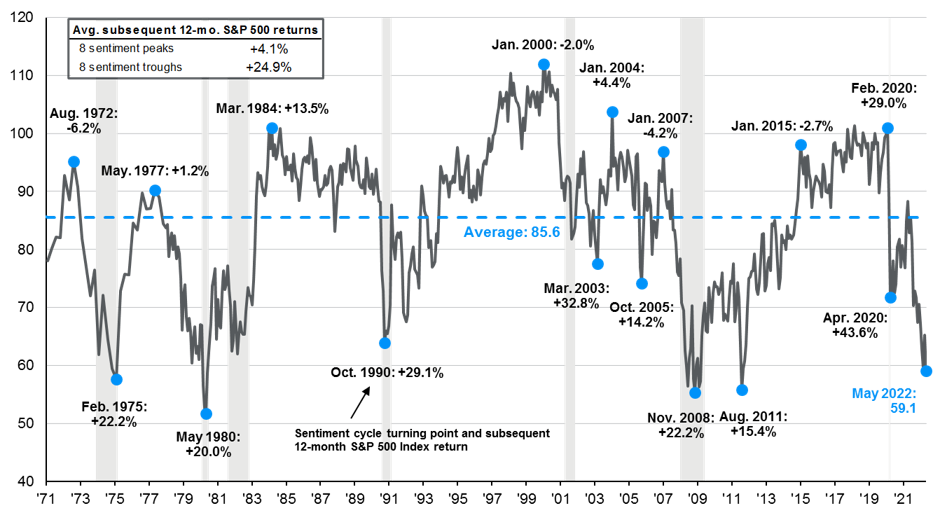Written by: Jack Manley
Long-term investors are facing a number of challenges today. Multi-decade-high inflation is eroding purchasing power and portfolio values, and recent volatility across capital markets has made the investment landscape look perilous. During periods of intense market stress, investors may decide to “take control” of their portfolios by selling out of the market, trying to time the bottom. Unfortunately, this usually results in locking in losses, further damaging portfolio values.
This behavior may be driven by loss aversion, as losses can hurt more than gains feel good. However, investors should first be aware that the worst and best days of the market are often clustered together, as we have recently highlighted. Moreover, the data clearly show that when sentiment is at its lowest, future market returns are generally strong.
Looking at 50 years of consumer sentiment data, it is possible to identify eight peaks and eight troughs – in other words, periods where Americans were feeling especially optimistic or pessimistic. Looking at subsequent 12-month S&P 500 returns from these peaks and troughs, an interesting pattern emerges: when investors felt most confident, the market returned on average just over 4% in the following year. By contrast, when investors felt most nervous, the market returned on average just under 25%. Today, sentiment is as low as it’s been in over a decade, as investors struggle with elevated volatility, hot inflation, rising interest rates and war in Europe.
Given this information, some investors may wonder if this is the “bottom”, or if there is more room left to fall. While in general we avoid market timing, it is particularly important in today’s market to consider the upside potential along with the downside. After all, the prolonged bout of weekly losses means that a return to the S&P 500’s previous peak in early January implies a 12-month return of almost 25%.
Moreover, avoiding timing the bottom means not having to predict when to buy back in, which is just as difficult: in fact, the second worst day of the recent market sell-off – April 29 – was followed in four trading days by the best day this period, dangerously close for investors trying to time exits and entries. In other words, finding the bottom in today’s market should not be of paramount concern.
Ultimately, investors should recognize that while recent volatility has been uncomfortable, it is likely to persist for some time. Instead of trying to time bottoms or investing off of sentiment, many would do well to step back and remember that it is always darkest just before the dawn.
Consumer Sentiment Index and subsequent 12-month S&P 500 returns

Related: What Are the Investment Opportunities in Renewable Energy?
Source: FactSet, Standard & Poor’s, University of Michigan, J.P. Morgan Asset Management.
Peak is defined as the highest index value before a series of lower lows, while a trough is defined as the lowest index value before a series of higher highs. Subsequent 12-month S&P 500 returns are price returns only, which excludes dividends. Past performance is not a reliable indicator of current and future results.
Guide to the Markets – U.S. Data are as of May 25, 2022.

